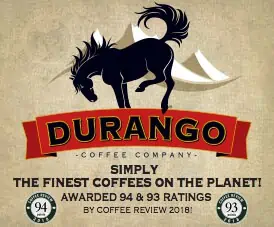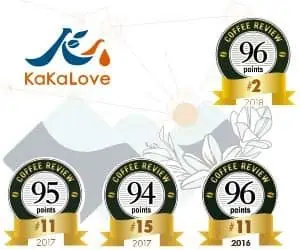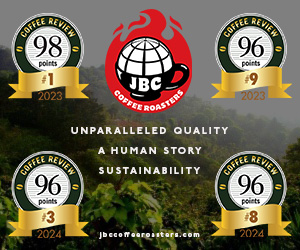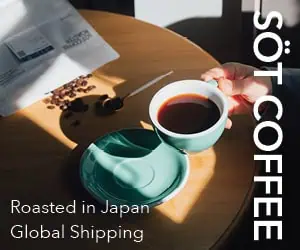House blend is a slippery term in coffee. It can suggest the straightforward and reliable, as in “house wine,” and it can mean something unusual but local, not to be had elsewhere, as in “only at our house.” Plus over the last decade it has taken on still another meaning. You find this last definition operative in the mid-market world of Starbucks and similar upscalish supermarket coffees. Here “house blend” seems to describe a blend brought to as little darker roast than a “breakfast blend” though not nearly as dark as blends labeled “espresso roast” or “French roast.” Finally, house blends, unique or not, are generally expected to offer value to the customer. The implication is, step back from the Kenyas and the fancy microlots and you can save a few bucks while still drinking a great coffee that everyone at the table will enjoy.
We sourced about forty coffees that fulfilled these overlapping definitions from a variety of perspectives, a pluralistic response probably appropriate to the individualistic world of specialty coffee.
Transcendent Comfort
Many of the submissions literally and helpfully labeled themselves “house blends.” (For a tongue-in-cheek take on the concept, see Badbeard Coffee’s 89-rated “This is My House (Coffee),” with its irreverent title and defiantly edgy flavor profile.) Other house or house-like blends clearly aimed at accessibility; these were high-end comfort coffees, something like a top chef’s version of familiar foods. This comfort took on subtly different forms, however.
The Green Mountain Coffee Roasters Our Blend (89) is quietly bright and New-Englandish; the Coffee Bean & Tea Leaf House Blend (90) impressed with its delicacy and balance; the Barrington Coffee Estate Blend (91) struck a ground somewhere between, a bit more robust than the Coffee Bean & Tea Leaf but more complex in sensory range than the Green Mountain.
I was especially struck by the Johnson Brothers Coffee Fair-Trade Organic House Blend (92). Sourcing Fair-Trade coffees that are pure enough to shine at the dramatically light roast applied by Johnson Brothers to this blend can be difficult. (It is considerably easier to source interesting Fair Trade green coffees than pure ones at this moment in history). However, the Johnson Brothers blend is virtually flawless in its balance and range, modest but distinctive, a coffee angel hanging around the house in street clothes.
In other cases samples arrived without the “house” or anything like it in the title, but were offerings that the roaster felt best corresponded to the “house blend” concept in some way, whether through accessibility and broad appeal and/or because employees recommend them as default choices for confused new customers. The Counter Culture Coffee Hominy Grill Blend (91) is a different kind of house blend – the “house” in this case being one of the many excellent restaurants for which Counter Culture provides custom blends. This cunningly designed blend seemed particularly house-like in the broader sense, given an impressive balance that wraps around and tames the coffee’s acidity without depriving us of its roundly tart pleasure.
Aggressive acidity, of course, is a no-no for house blends because it limits accessibility, as does a bitterish or extreme dark roast. The selection of coffees submitted for this cupping seemed to confirm that the specialty industry acknowledges that challenging extremes like big acidity or striking characteristics like Ethiopia flowers or Sumatra earth are not characteristics of a properly versatile, you-all-come style house blend.
Pushing the Envelope (or the Walls)
That having been said, two roasters submitted blends reviewed here that push the envelope of balance toward the edges of exotic. These are houses, perhaps, but houses with unusual floor plans designed by architects of possibly fringy genius. The Paradise Roasters Romance by Paradise blend (95) is a thorough-going success, a variant on the Mocha-Java blend, the old and honored formula that combines a fruity dry-processed coffee from Yemen or Ethiopia with a second lower-toned, richer coffee, traditionally a Java or Sumatra. Not much earth shows up here, however, and the fruit is opulent yet nearly free of ferment, making this an arguably house-blend tamed Mocha-Java.
On the other hand, the Just Coffee El Corazon (88) may be the house on the block that no one completely likes but everyone likes to talk about. The multiple cups we tasted ranged from superb – big-bodied, intense with earth and berry notes – to one that was sharply and unpleasantly musty. Nevertheless, it is a blend that represents an admirable ambition, plus I was much taken by the crazed, leave-no-surface-unprinted bag design. The inspiration appears to be 1920’s Russian black-and-red poster design crossed with macabre folk art (the “corazon” or heart represented on the bag, for example, includes disconcerting detail like a severed aorta).
Well, fringy and iconoclastic to suavely gracious, these were all worthy blends to my palate. Different houses for different folks.
2009 The Coffee Review. All rights reserved.










